A Visual Guide to AWS
Radio spectrum refers to the whole range of radio frequencies. Radios can transmit on different frequencies in the same area at the same time without interfering, so frequency is a handy way to divide up the airwaves for different uses.
Frequency is measured in Hertz, which is abbreviated Hz. The whole range of radio spectrum is pretty huge: 10,000 - 300,000,000,000 Hz. The metric system is used to abbreviate that, so 300,000,000,000 Hz would typically be written 300 GHz.
Different frequencies have different natural properties. Lower frequencies travel farther and penetrate solids better, while higher frequencies can carry more information (faster data rates, etc.) The best balance of these properties for the purpose of cell phones is in the range of roughly 700 - 2,500 MHz. (2,500 MHz could also be written 2.5 GHz, since 1 GHz = 1,000 MHz.)
A specific range of frequencies allocated for a specific purpose is called a "band". The existing "2G" bands for cell phones are shown below:
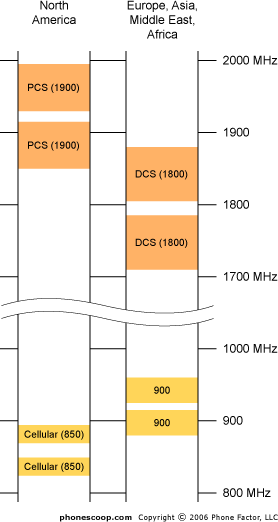
As you can see, there are two major existing bands in North America: Cellular and PCS. There are also SMR bands used for iDEN, but that's a whole 'nother can of worms, so we're skipping those for now to keep things simple.
(If you're wondering why there are two sections of each band, just hold your horses... I'll get to that.)
You can also see that Europe has similar bands, but they don't quite match up. There is a global organization that tries to "harmonize" global spectrum use and avoid what happened above, but it's not always possible. Just imagine the complexity of the US spectrum chart on the previous page, multiplied by every country on the planet, (since each country ultimately manages its own spectrum,) and you'll start to understand how hard it can be to coordinate these things globally.
In the chart above, the lower bands came first. They were the original bands for cellular phone service. North America's upper band - PCS - was auctioned off in the mid-90s. It was auctioned off in six blocks over several years.
Even though PCS was a sizable chunk of spectrum, and only auctioned off a decade ago, the explosive growth of cell phones in the past decade has left wireless companies (and T-Mobile especially) clamoring for more spectrum.
Although US carriers are allowed to launch "3G" technology in the existing "2G" bands, (and most have already done so,) the existing spectrum wasn't enough to handle everything carriers needed and wanted to do.
The same is true in Europe, where they recently addressed the spectrum shortage by auctioning off spectrum in what's generally called the "2100" band. (It's actually in both the 2100 and 1900 bands, but again, we'll get to that later.)
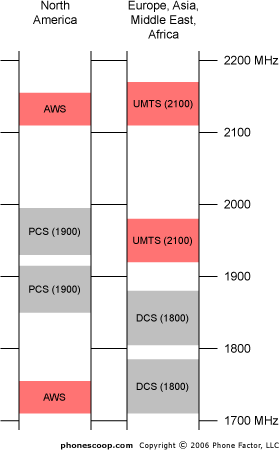
The FCC wanted to harmonize its "new" AWS spectrum with Europe's UMTS 2100 band, since both would be used for new "3G" phone service. Unfortunately, as you can see above, the lower half of Europe's UMTS 2100 band almost completely overlaps with our PCS band, so complete harmonization wasn't an option.
However, given the circumstances, the FCC did do a pretty good job of harmonizing AWS with the rest of the world. The upper part does line up perfectly with Europe's UMTS 2100 band, and the lower part does line up with Europe's DCS band. Therefore manufacturers already building GSM+WCDMA "world phones" actually won't have to support any additional frequency bands at all.
That's not to say that you won't need a new phone to use a network that uses the AWS band; you will. No current phones (as of October 2006) are capable of operating in the AWS band. It's just that the specific bands the FCC chose will make it relatively easy for phone makers to build new 3G world phones compatible with AWS.
So just for the sake of the big picture, here's the whole spectrum situation, including AWS:
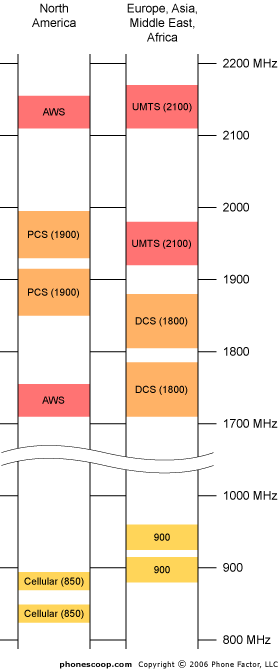
This doesn't include SMR used by iDEN networks like Nextel, nor does it include Japan, which uses its own unique bands. Other parts of the world - such as South America, India, China, and Australia - have allocated some spectrum that aligns with North America, and other spectrum that aligns with Europe.
Now to finally explain why each "band" is really two bands:
All major mobile phone technology to date has used "paired" spectrum. That means each "band" is actually a pair of bands, with one half being used for towers to transmit to phones, and the other half being used for phones to transmit to towers.
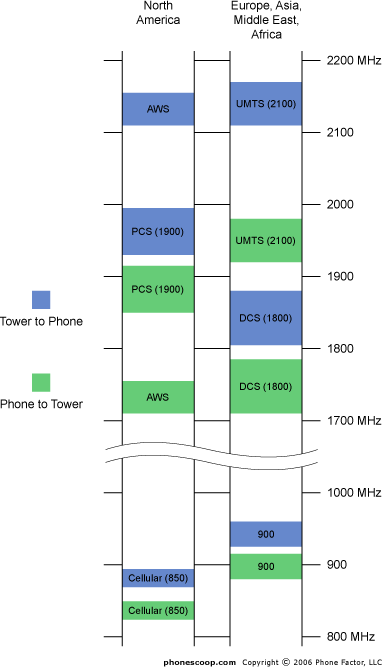
In other words - in the chart above - phones "listen" on the blue bands, and "talk" on the green bands. Vice-versa for towers (which in industry lingo are called "base stations".)
The chart above also shows how each half of AWS aligns perfectly with bands already used in Europe and Asia for communication in each direction.
The chart above also shows why current UMTS 2100 phones aren't compatible with the AWS band. UMTS 2100 phones transmit to towers in 1920-1980 MHz range, which is what towers using the PCS band use to transmit to phones in North America. Therefore UMTS 2100 phones are already designed to not transmit in that range when they're in the US, since that would interfere with PCS networks. Even if that weren't an issue, an AWS network can only "listen" to the 1710-1755 MHz range, so it could never "hear" the 1920-1980 MHz transmissions of a UMTS 2100 phone.


 iPhone 15 Series Goes All-In on USB-C and Dynamic Island
iPhone 15 Series Goes All-In on USB-C and Dynamic Island
 iPhone 16 Brings More Features to All Price Points, Including New Camera Control
iPhone 16 Brings More Features to All Price Points, Including New Camera Control
 Hands On with the Boost Summit 5G
Hands On with the Boost Summit 5G
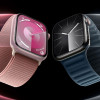 Apple Watch Series 9 Detects Finger Gestures, Brings Siri On-Device
Apple Watch Series 9 Detects Finger Gestures, Brings Siri On-Device
 Google Now Lets You Search with Camera + Voice
Google Now Lets You Search with Camera + Voice







